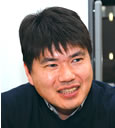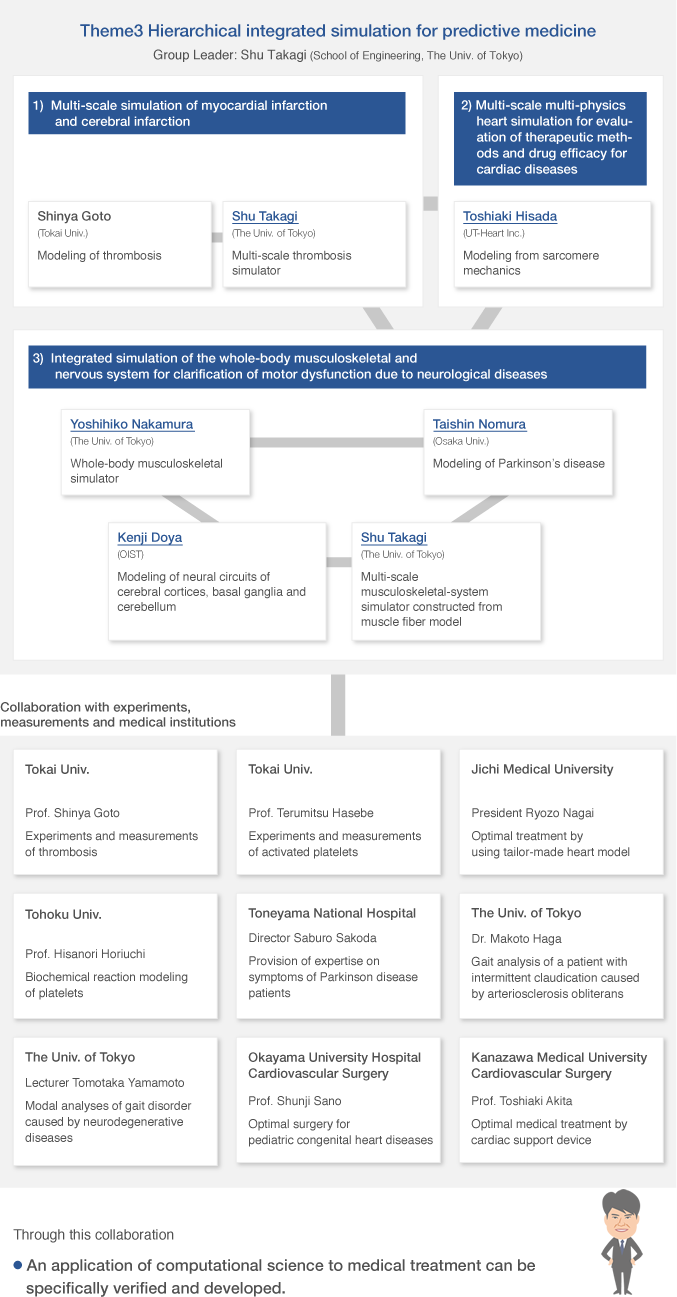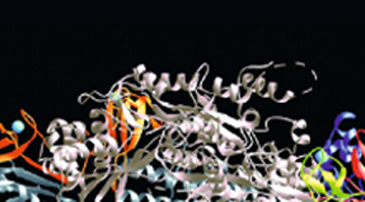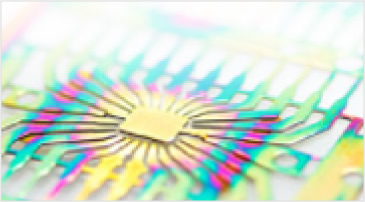Theme3 Hierarchical integrated simulation for predictive medicine
Hierarchical integrated simulation for predictive medicine

Group Leader:
Shu Takagi
(School of Engineering, The University of Tokyo)
The categoly: BEST VISUALIZATION OR SIMULATION
Summary
Simulations have been developed for different organ systems, such as the circulation, musculature, skeleton, brain, and nervous system. By integrating them, we will be able to gain an understanding of complex conditions such as heart disease and movement disorders, and to develop optimal personalized medicine to treat these illnesses.
In the past, computers have been used to study individual organs such as the brain, nerves, muscles, heart, and blood vessels. With the K computer, it becomes possible to study those systems not in isolation, but together. We are engaged in a collaborative effort, with medical professionals, to create a new system of medical science. Based on the results of that research, we aim to make possible detailed consideration of medical treatment and prediction of prognosis.
[upper Movie]The heart is a pump circulating blood containing nutrients and oxygen to the whole body. In the heart simulator, contraction and relaxation of muscle are reproduced based on the statistical behavior of molecules, which in turn are strongly coupled with the computation of blood flow and pressure. By reproducing a highly realistic human heart whose behavior strictly follows the physical and physiological principles in the computer, the simulator can help doctors choose a treatment option for heart disease patients by accurately predicting its outcome. In fact, projects to determine the optimal operative strategy for individual patients by performing in silico tailor-made cardiac surgeries have already been under way in collaboration with the cardiac surgeons.
[lower left Movie] By looking at things at the molecular and cellular level, we can examine the process through which the blood, which normally flows smoothly, coagulates as a result of disease, finally leading to blockage.
[lower right Movie] By creating a simulation model of the heart, based on the movements of individual heart muscle cells, we can clarify the relationship between abnormalities at the micro level and heart disease.
We aim at reproducing processes in which thrombus growth from thrombotic adhesion to atherosclerotic lesions, finally causing myocardial infarction, and which include a protein molecular model, blood cells and blood coagulation.
Approach during the Past Five Years and its Achievements
Publications
1. Jan Moren, Tomohiro Shibata, Kenji Doya:
“The mechanism of saccade motor pattern generation investigated by a large-scale spiking neuron model of the superior colliculus“
PLOS One, Vol. 8, e57134 (2013)
2. Takumi Washio, Jun-ichi Okada, Akihito Takahashi, Kazunori Yoneda, Yoshimasa Kadooka, Seiryo Sugiura, Toshiaki Hisada:
“Multiscale Heart Simulation with Cooperative Stochastic Cross-Bridge Dynamics and Cellular Structures“
SIAM Multiscale Modeling & Simulation 11-4 (2013), pp. 965-999
3. Seo K, Inagaki M, Hidaka I, Fukano H, Sugimachi M, Hisada T, Nishimura S, Sugiura S:
“Relevance of cardiomyocyte mechano-electric coupling to stretch-induced arrhythmias: optical voltage/calcium measurement in mechanically stimulated cells, tissues and organs“
Progress in Biophysics and Molecular Biology, 115(2–3), pp. 129–139 (2014)
4. Susanne Kunkel, Maximilian Schmidt, Jochen M. Eppler, HansE.Plesser, Gen Masumoto, Jun Igarashi, Shin Ishii, Tomoki Fukai, Abigail Morrison, Markus Diesmann, and Moritz Helias:
“Spiking network simulation code for petascale computers.“
Frontiers in Neuroinfomatics, Volume 8 (2014)
5. Naoto YAMAMURA, Jose Luis ALVES, Toshiaki ODA, Ryuta KINUGASA, Shu TAKAGI:
“Effect of tendon stiffness on the generated force at the Achilles tendon – 3D finite element simulation of a human triceps surae muscle during isometric contraction“
Journal of Biomechanical Science and Engineering, Vol.9, No.3 (2014), p.13-00294.
Group organization

As of April 1, 2015






